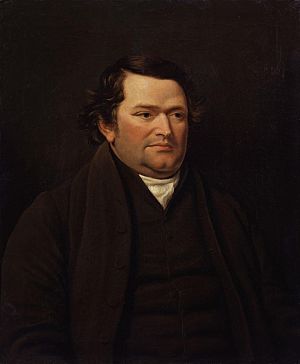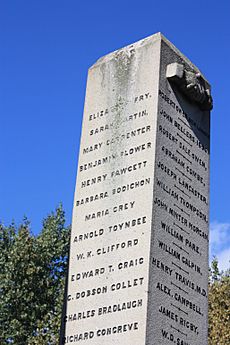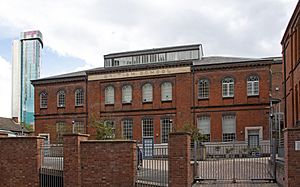Joseph Lancaster facts for kids
Quick facts for kids
Joseph Lancaster
|
|
|---|---|

Joseph Lancaster, by John Hazlitt, c. 1818
|
|
| Born | 25 November 1778 |
| Died | 23 October 1838 (aged 59) New York City, New York, US
|
| Nationality | British |
Joseph Lancaster (born November 25, 1778, died October 23, 1838) was an English Quaker who created a new way to teach many students at once. He developed a special teaching method called the "monitorial system." This system helped schools teach many children cheaply and effectively. In the early 1800s, his ideas were used in new schools built in busy industrial cities.
Contents
Joseph Lancaster's Early Life
Joseph Lancaster was born in Southwark, south London, England. This was on November 25, 1778. He grew up in a big family. His father, Richard Lancaster, was a soldier who later made sieves. His mother, Sarah Faulkes, owned a shop.
As a teenager, Joseph was very interested in missionary work. He wanted to travel to Jamaica to help people. He even ran away from home once, but was brought back. Joseph later joined the Society of Friends, also known as the Quakers. He decided he wanted to become a teacher.
Becoming a Schoolmaster
In 1798, Joseph Lancaster started a free elementary school with his father's help. He believed that all children, especially those from poorer families, should get an education. In 1801, he opened another free school in Borough Road, Southwark. This school used his new teaching method.
The Monitorial System
Lancaster's teaching method was called the "monitorial system." It allowed one teacher to teach hundreds of students at the same time. How did it work? Older or more advanced students, called "monitors," would teach smaller groups of younger students. Once a student learned something, they would then teach it to the next student. This is similar to what we now call peer tutoring.
This system was very helpful because it meant schools did not need to hire many assistant teachers. This made education much cheaper. Another educator, Andrew Bell, developed a similar system in India around the same time.
In 1803, Lancaster wrote a book called Improvements in Education as it Respects the Industrious Classes of the Community. This book made his ideas famous. Many people visited his Borough Road school to see his system in action.
Support for Lancaster's Schools
Lancaster's school in Borough Road was called the Royal Free School. In 1805, King George III even met with Lancaster. Many important people supported his work, including two royal dukes.
His supporters were often people who believed in new ideas and wanted to help the poor. They included John Russell, 6th Duke of Bedford, and William Allen, who was also a Quaker.
In 1808, a group of supporters created "The Society for Promoting the Lancasterian System for the Education of the Poor." This group later became known as the Royal Lancasterian Society. They helped raise money for Lancaster's school and spread his ideas.
Joseph Lancaster traveled all over Britain and Ireland. He advised people on how to set up schools using his methods. He often explained that his system was very affordable. He said that one teacher could manage over a thousand children for a very low cost. He also insisted that his schools should welcome all children, no matter their religion.
Challenges and Opposition
Not everyone supported Lancaster's new schools. In England, there were already other types of schools. These included small private schools, charity schools, and Sunday schools.
Some people worried about Lancaster's system. They were concerned that his schools did not focus enough on specific religious teachings. They feared that teaching only "leading principles of Christianity" might make children less religious.
After some initial success, Lancaster's schools also faced criticism for their teaching quality and discipline. While Lancaster did not use physical punishment like hitting, he used other strict methods. For example, misbehaving children might be tied up or placed in cages above the classroom. Some people, like writer Robert Southey, thought these punishments were too harsh.
Over time, the Church of England and even the monarchy became less supportive of Lancaster's methods.
Spreading Ideas in the Americas
In 1818, Joseph Lancaster and his family sailed to the United States. He had many important supporters there, including DeWitt Clinton, who had already started a Lancasterian school in New York in 1806.
Lancaster helped open the first model school in Philadelphia. This school trained teachers to use his system. He also started a school in Baltimore, but it did not last long due to money problems. A successful Lancasterian school was set up in New Haven in 1822.
Travels in South America
Simón Bolívar, a famous leader in South America, had visited Lancaster's school in London in 1810. In 1823, Lancaster sent a letter to Bolívar in Gran Colombia (a large country that no longer exists).
Lancaster and his family arrived in Venezuela in May 1824. His daughter and her husband later moved to Mexico. Lancaster stayed in Caracas, Venezuela, from 1825 to 1827. He even got married there for the second time, with Bolívar attending the wedding.
However, things did not go well for Lancaster in Caracas. He struggled because he did not speak Spanish. He also had disagreements with the British consul and with Bolívar himself over money for the schools. Lancaster secretly left Caracas in April 1827 and returned to the United States. Some schools in Venezuela continued to use his name for a long time.
Lancaster also visited Lower Canada (now part of Canada) in 1829. He opened a school in Montreal, but his efforts to get funding failed, and he moved back to the United States.
Death and Legacy
Joseph Lancaster died on October 23, 1838, in New York City. He was injured in a street accident.
At the time of his death, it was believed that between 1,200 and 1,500 schools were using his teaching methods. The society that supported him, the BFSS (British and Foreign School Society), was very successful in the early 1800s. However, the monitorial system became less popular later on.
Today, only one Lancasterian schoolroom built exactly to his plans still exists. You can find it at the British Schools Museum in Hitchin, England.
Works
- Improvements in Education (London, 1803; New York, 1807)
- The British System of Education (Washington, 1812)
- Epitome of the Chief Events and Transactions of my own Life (New Haven, 1833).
Family Life
Joseph Lancaster was married twice:
- In 1804, he married Elizabeth Bonner. They had a daughter named Elizabeth (Betsy). Elizabeth died in Baltimore.
- In 1827, he married Mary Robinson in Caracas. Mary was a widow with three children from her first marriage.
On April 20, 1824, Betsy, Joseph's daughter, married Richard Madox Jones in Philadelphia. Richard had been trained in Lancaster's teaching system. He later became an organizer for Lancasterian schools in Mexico. Joseph Lancaster's family still lives in Mexico today.
See also
 In Spanish: Joseph Lancaster para niños
In Spanish: Joseph Lancaster para niños



